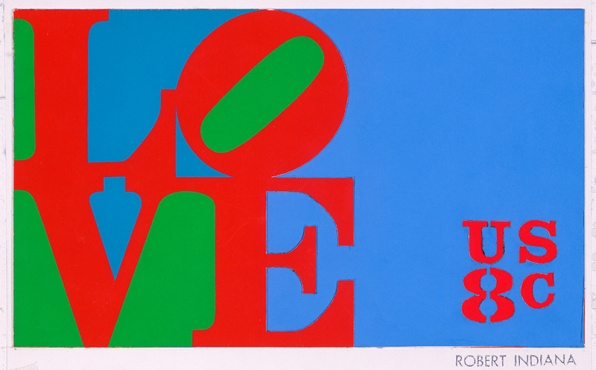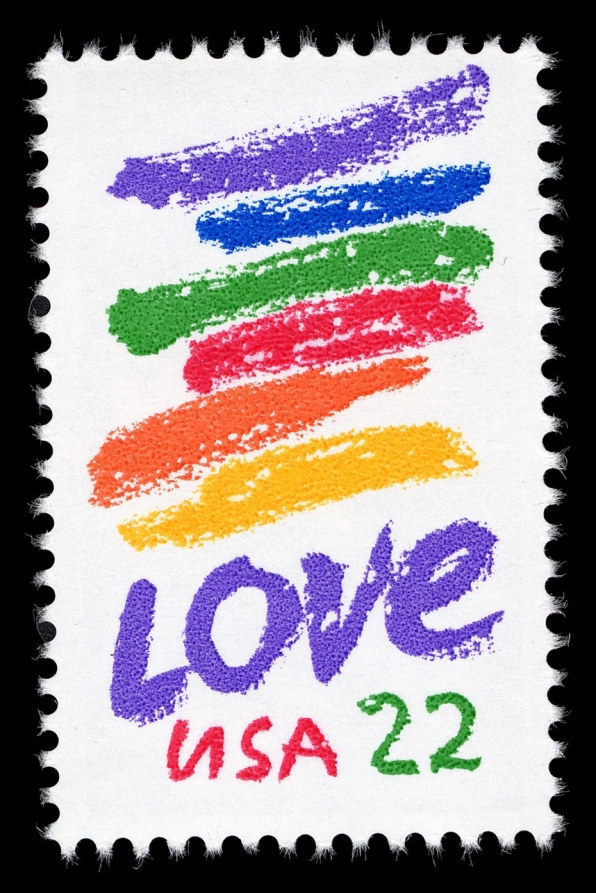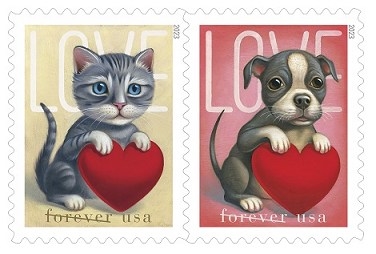By Hunter Schwarz
Illustrator Bailey Sullivan couldn’t believe it when she got the email asking if she’d be interested in designing a U.S. Postal Service Love stamp. “I just started crying because it was such a huge, huge project,” she says.
Sullivan remembered the 2015 Love stamp with “forever” written in looping letters designed by Jessica Hische, an illustrator famous for her lettering style. For her wedding invitations, Sullivan used the 2018 stamps designed by Anna Bond that shows “love” written in cursive and covered in flowers. “I felt hugely tied to that, putting those on my invitations,” she says.
So when USPS tapped Sullivan to design a stamp for both 2021 and 2022, it felt as if she’d come full circle. For 2021’s stamp, Sullivan designed a block-letter love stamp with hearts. For the following year, she illustrated a pair of pink and blue floral stamps. Since then, she says she has received messages from people who used her stamps for their own wedding invitations.
Sullivan’s connection to the Love stamp is reflective of just how popular the saccharine postal tradition has become. Since USPS issued the first Love stamp 50 years ago, in 1973, it’s been one of the most beloved, and best-selling.
The stamp was the result of a letter to the postmaster general: “When one writes a love letter, there is nothing that distinguishes it from regular, everyday business mail,” an Oklahoma man wrote, according to Linn’s U.S. Stamp Yearbook 1984. “Why not have a stamp designed for lovers? As one lover to another, I ask that you arrange to have a stamp made for lovers, so our letters may stand out among all others.” Released in time for Valentine’s Day, the Love stamps carry a sentimentality that few other government-issued products can compete with.
Robert Indiana, a pop artist of the 1960s, designed the first Love stamp in 1973. It was based on his painting Love, commissioned by the Museum of Modern Art for its 1965 Christmas card. The red, green, and blue stamp stacks the word “love” onto itself with the O set on a slant. The postal service described it as “a Special Stamp for Someone Special,” but some customers balked at Indiana’s design, describing it as a “hippie stamp” and “something concocted on a hashish couch,” according to the Smithsonian National Postal Museum. But it was popular, with more than 300 million stamps issued. (In fact, over the next several decades, the artist would go on to create a series of more than 50 sculptures of the iconic design in various palettes and even languages for cities all over the world.)

But Indiana’s Love stamp was conceived as a one-off, and it would be nine years before Mary Faulconer’s stamp spelling out “love” in flowers would be released, followed by a stamp in 1984 by designer Bradbury Thompson that swapped out the V in “love” for hearts. Former nun-turned-designer Corita Kent created an ink-and-watercolor collage showing colors of the rainbow for her 1985 stamp. She imagined it being unveiled at the United Nations, so when its debut was held on the set of the television series The Love Boat, Kent, who sought dispensation from her vows in 1968, chose not to attend. The TV definition of love wasn’t very deep and everything was resolved in an hour, she said, and she called it dangerous to educate people that love happened that fast.
“The common thread that you see throughout all of her work is this sense of humanitarian care and love,” says Nellie Scott, director of the Corita Art Center. “So when she was commissioned by USPS to make this stamp, I think that was really at the core of what she had in mind, a focus on humanitarian love versus romantic love.”

USPS sold more than 700 million of Kent’s stamps. Despite a premiere that didn’t match the message of her artwork, Scott says she imagined the artist appreciated how her work was used on everyday things, like paying bills or sending a letter to grandma: “The idea of this kind of democratic use of the stamp I think was something I would imagine she enjoyed.”
Stamps weren’t designed to be art. USPS’ first stamps were purely utilitarian, showing how much had been paid to get letters from point A to B. Like currency, the first general-issue postage stamps approved by Congress in 1847 showed founding fathers George Washington and Benjamin Franklin. The popularity of Love stamps proved that Americans were eager for decorative stamps that weren’t afraid to show emotion, and today, USPS regularly releases commemorative stamps that celebrate American culture and history.
A well-designed Love stamp can be used year round, and more than 200 million were printed this year. In choosing a design, the USPS considers how they’ll be used, from Valentine’s Day to Mother’s Day to weddings and family.
“The nation seems to like the sentimentality, but I also think that we’ve tried to provide some alternatives so that we’re not doing the same thing year after year,” says Bill Gicker, USPS director of stamp services.
Chris Buzelli, the illustrator who designed 2023’s Love stamps, sent over 20 to 30 ideas when he was asked for submissions, including a concept of a melting heart. “There’s a lot of flowers, there’s a lot of birds,” he says. “But I wanted to go in different directions.” Ultimately, USPS decided on one of his earliest sketches, showing a dog based on his dog, Minnesota, with a heart. A companion stamp with a cat was based on his childhood cat, Circa.

In the half century since Indiana’s stamp, the USPS has produced more than 70 Love stamps, creating a canon of usable pop art that’s adorned decades’ worth of wedding invitations and love notes. New Love stamps have been issued annually since 2004, and many have become cultural hallmarks of their own. When Kent died in 1986, obituaries mentioned her stamp at the top, and today the USPS sells merchandise like shirts and cushions depicting popular past designs. “There’s a need for the Love stamps, a purpose for them,” Gicker says.
Technology has reduced our reliance on physical mail for communicating—the volume of first-class mail sent in the U.S. has fallen from a high of 103,656 pieces in 2001 to 50,695 pieces in 2021. But research has shown that sending and getting mail can be good for people. Studies have found that sending letters of gratitude can increase happiness and life satisfaction, and research from the USPS in the first months of the pandemic found that 65% of U.S. adults said receiving mail lifts their spirits. Sending a little love can go a long way, it turns out.
(55)